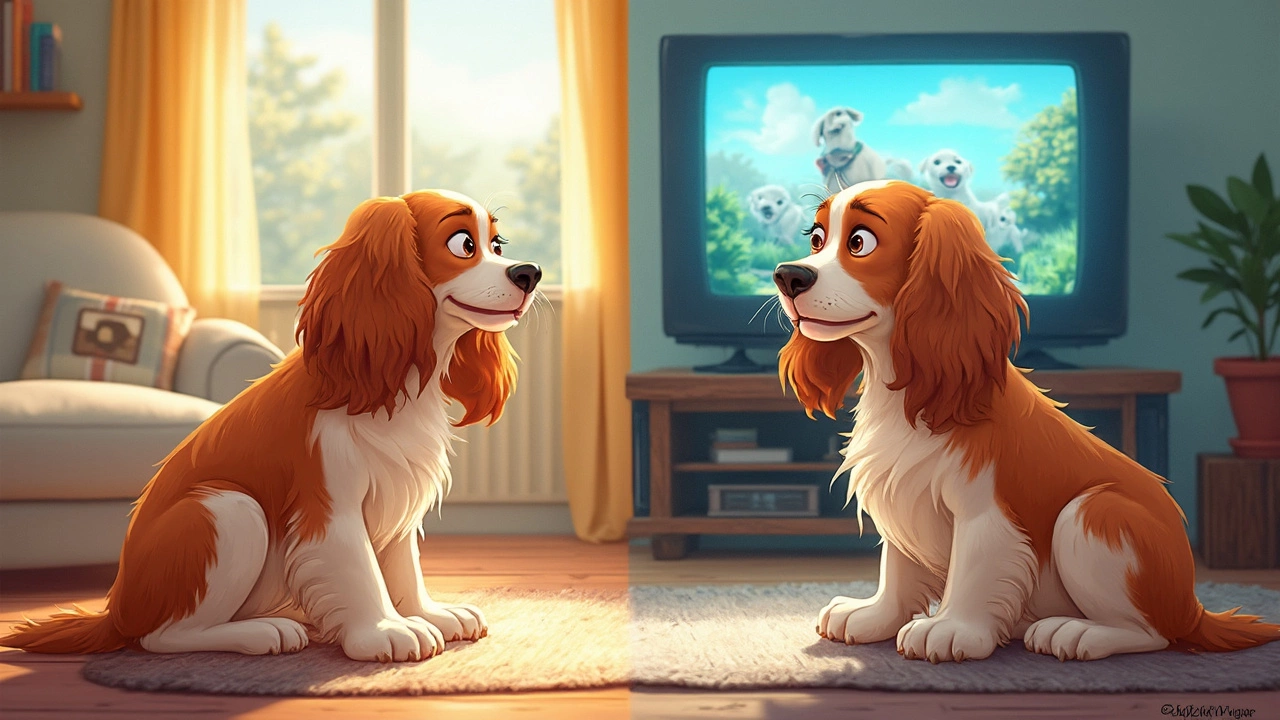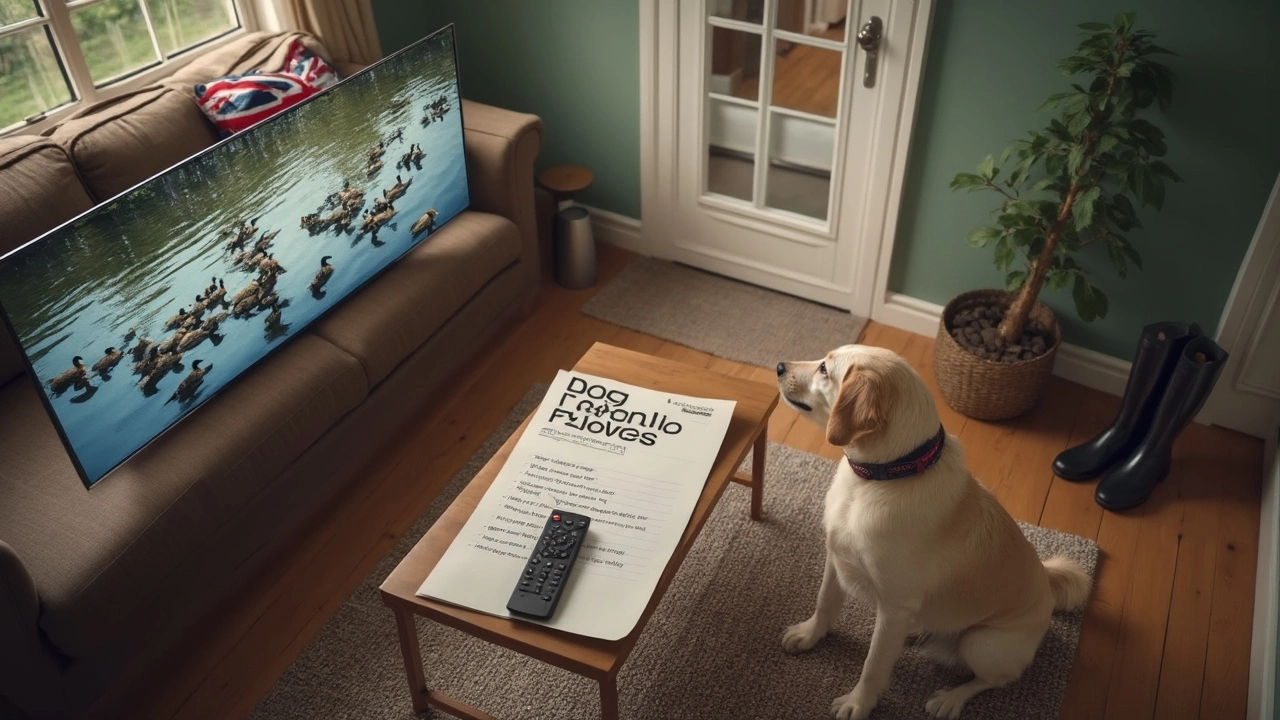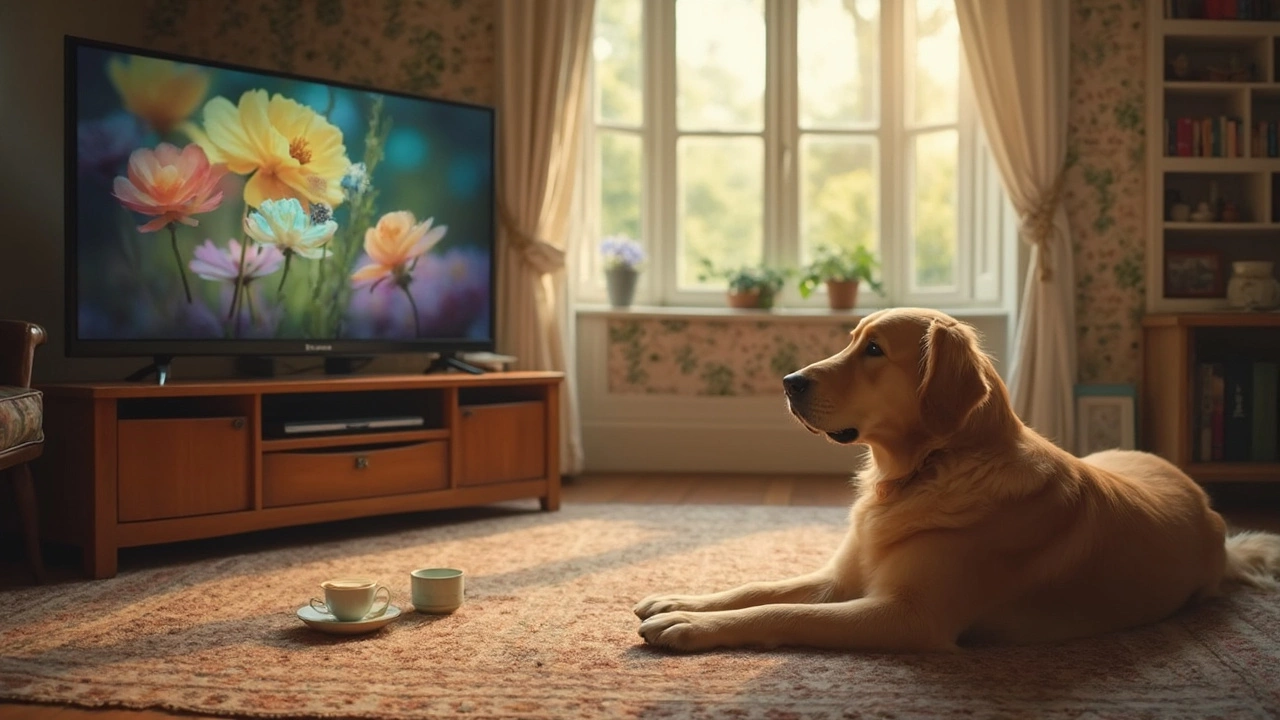Picture this—you’re rushing out the door, shoes half-tied, and you pause. Should you leave the TV on for your dog? That question sits in your head all day, popping up between meetings and on the drive home. Maybe you imagine your pup sprawled on the couch, paw twitching, eyes glued to a nature documentary, totally absorbed. Or maybe you worry it’s just empty noise filling the room. Dog owners everywhere debate this one. Some swear by it. Others say it’s pointless—or might even stress their pups out. But what’s actually going on in your dog’s head when the TV is on? Turns out, the answer mixes a dash of science, a heap of anecdotal stories, and a sprinkling of doggy quirks you just can’t predict.
What Does Your Dog See and Hear on TV?
First off, dogs don’t see screens the way we do. Human eyes blend moving images into smooth videos at 24 frames per second. Dogs need about 70 frames per second to see a continuous flow. So older TVs, with a spottier refresh rate, probably looked flickery to them—about as exciting as a broken strobe light. Newer HD and 4K TVs deliver those faster frame rates, which means more dogs might actually see convincing motion rather than a confusing blur.
Colors? Dogs aren’t totally colorblind, but their vision is tuned to shades of blue and yellow. Reds and greens? Not so much. That lush green dog park on Animal Planet looks way less exciting to a dog than it does to us. And sound? Here’s where things get interesting. Dogs can hear higher pitches and a wider range of sounds. That faint background bird noise you barely notice might grab your dog’s full attention.
- Dogs notice quick movement—think squirrels, bouncing balls, or dogs running onscreen.
- Loud, sudden sounds might startle sensitive pups, while calming music or gentle voices can reassure.
- Familiar sounds, like barking, doors closing, or laughter, might trigger curiosity or even barking back.
Some studies out of the University of Wisconsin (2023) suggest that about 38% of dogs show visual interest in TV for more than a few seconds, though only 15% seem to follow scenes with sustained focus—like when another dog appears. Breed, age, and personality all matter. Herding breeds and hounds, for instance, often react to moving shapes and animal noises, while senior dogs might seem indifferent.
Does TV Actually Help Dogs Feel Less Lonely or Anxious?
If you’ve got a dog that starts to stress the minute you grab your keys, you might desperately want a magic fix. Pet TV shows and YouTube channels for dogs are popping up everywhere, usually promising to “reduce canine anxiety.” The research supporting this is a bit mixed, though. One 2022 survey from Tractive tracked 1,500 dogs left home alone; about 26% showed fewer stress behaviors like barking or pacing when left with a TV or radio playing. That’s not nothing, but it’s far from a guarantee.
Here’s what actually seems to matter:
- Background noise can mask stress triggers—think slamming doors or honking cars outside.
- TV provides a sense of “company,” especially for dogs that hate silence.
- Some pups get distracted by onscreen movement, interrupting the cycle of boredom or worrying behavior.
- On the flip side, if your dog is sound-sensitive or easily startled, action movies or dramatic shows might make things worse.
TV isn’t a cure for separation anxiety—don’t fall for ads promising miracles. For dogs with full-blown anxiety (think: destructive digging, nonstop barking, accidents inside), you’ll probably need routines and training. But for a bored or mildly lonely pup, the right TV programming might take the edge off those long hours apart.

Best Types of TV Content for Dogs
Not all shows are created equal in a dog’s eyes. Paw Patrol? Too cartoony. Fast-moving wildlife shows? That’s more like it. In fact, some cable providers even have “DogTV” channels designed just for canine viewers. These shows are made with high-contrast colors, steady camera work, and relaxing audio.
Here’s a quick rundown of the types of TV content dogs tend to enjoy—or at least notice:
- Nature documentaries with lots of animal movement and minimal narration
- Shows with birds, squirrels, or other critters darting around
- Home videos featuring other dogs barking, running, or playing fetch
- Programs with calming classical or low-frequency music
- Dog-specific YouTube channels like “Relax My Dog” (over 2 million subscribers in 2025!)
Avoid content with sudden explosions, shouting, or screechy audio. Even dog-friendly commercials might set some pets on edge, depending on your dog’s past experiences or current mood.
| Type of Programming | Dog Engagement (Est. %) | Behavior Reported Most |
|---|---|---|
| Animal/Nature Shows | 38% | Watching, head tilts, tail wagging |
| Children’s Cartoons | 17% | Brief glances, minimal interaction |
| Sports/Action Shows | 21% | Pacing, occasional barking |
| Dog-specific Channels | 44% | Approaching screen, playful barking |
Tips for Making TV Work for Your Dog (and You)
Ready to give this whole TV-for-dogs routine a whirl? Doesn’t take much. But, like anything with pets, some trial and error goes a long way. Start with shows or channels tailored for pets, then observe how your dog reacts. Watch out for these cues: do they go stiff, start barking, or just snooze through the noise—maybe your pup’s not much of a fan. On the other hand, if you spot head cocks, tail wags, or your dog actively moving closer to the screen, you might just have a TV buddy on your hands.
- Pick high-def channels. Your dog will see movement better and might actually recognize what’s happening onscreen.
- Pay attention to volume. Not too loud—dog ears are sharp. Too much noise can overwhelm.
- Keep the remote nearby. If something sets your pup off (aggressive barks, alarms, shrieking sounds), switch channels fast.
- Keep content light. Stick to shows with calm visuals and sounds. Nature walks beat war documentaries, every time.
- Mix it up with other enrichment toys—don’t rely solely on TV to keep your dog happy. Treat puzzles, chew toys, or snuffle mats fill in the gaps.
Get to know your own dog’s quirks. Maybe yours loves chase scenes but snoozes through birdwatching. Test and tweak your choices as you go. Some owners find their nervous dogs calm right down if their favorite “voice” (maybe your own, or a certain actor) is playing. Others see zero effect—there’s no guarantee every dog will care.

Putting Screen Time in Perspective: Should Every Dog Have TV On?
Here comes the million-dollar question: should you leave the TV on for your dog when you step out? There’s no blanket answer. Dogs are as individual as people. Some treat TV like white noise and drift off. Others get riled up at the flicker of any screen. If you’ve got a dog that already chills solo, extra noise might just be extra hassle (and a bit of guilt if you forget to turn it off!).
But if your routine involves a long workday, a bustling city with weird sounds, or a dog that shadows your every move, TV can fill a small gap. It won’t cure loneliness, but it creates a little bubble of normal. Some owners even claim it helps with training away pesky habits. You won’t know until you try. Watch your dog, take mental notes, and don’t be afraid to hit “off” if it’s not working.
One last tip—always check cords and remotes. Some pups are infamous for chewing anything new in their environment, and the last thing anyone wants is a trip to the vet over a chewed-up HDMI cable. Use wall-mounted TVs when possible or keep wires tucked away.
What about TV marathons? Even if your dog is obsessed with squirrels onscreen, remember the value of real exercise and fresh air. No amount of digital enrichment replaces a romp at the park or a slow sniffy walk. But if the TV soothes your dog (or just makes you feel a little better while you’re away), embrace it as part of your routine. Your dog won’t judge your taste in reruns—promise.
